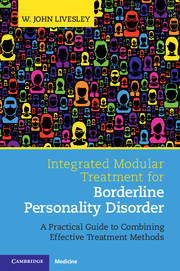 Integrated Modular Treatment for Borderline Personality Disorder
Integrated Modular Treatment for Borderline Personality Disorder Book contents
- Frontmatter
- Dedication
- Contents
- Preface
- Section 1 Introduction and Framework for Understanding Borderline Personality Disorder
- Section 2 Assessment and Treatment Planning
- Section 3 General Treatment Modules
- Section 4 Safety, Containment, and Engagement: The Initial Phase of Treatment
- Section 5 Improving Emotional Regulation and Modulation
- Section 6 Exploration and Change: Treating Interpersonal Problems
- Section 7 Constructing an Adaptive Sense of Self
- Introduction
- 21 Building a More Coherent Self
- 22 Promoting an Adaptive Self-Narrative and Flexible Working Selves
- 23 Getting a Life, Constructing a Personal Niche
- Section 8 Retrospect and Prospect
- References
- Index
Introduction
from Section 7 - Constructing an Adaptive Sense of Self
Published online by Cambridge University Press: 16 February 2017
- Frontmatter
- Dedication
- Contents
- Preface
- Section 1 Introduction and Framework for Understanding Borderline Personality Disorder
- Section 2 Assessment and Treatment Planning
- Section 3 General Treatment Modules
- Section 4 Safety, Containment, and Engagement: The Initial Phase of Treatment
- Section 5 Improving Emotional Regulation and Modulation
- Section 6 Exploration and Change: Treating Interpersonal Problems
- Section 7 Constructing an Adaptive Sense of Self
- Introduction
- 21 Building a More Coherent Self
- 22 Promoting an Adaptive Self-Narrative and Flexible Working Selves
- 23 Getting a Life, Constructing a Personal Niche
- Section 8 Retrospect and Prospect
- References
- Index
Summary
Introduction
The final phase of therapy seeks to construct a more adaptive self and a life worth living. Systematic work on these issues probably only occurs with relatively few patients. Most therapies that proceed beyond the crisis management phase terminate after emotion regulation improves and after some initial work on interpersonal problems. However, evidence suggests that even after apparently successful treatment many patients still have difficulties. Hence this phase is important if treatment is to achieve something more than symptomatic improvement and if patients are to be helped to live more satisfying lives.
Therapeutic work on constructing an adaptive self differs from the work of earlier phases of treatment that were largely concerned with exploring, strengthening, and restructuring already existing behaviours and schemas. Now the task is not to analyse but rather to synthesize – to construct a new self structure and narrative. This means that integration is now not only an approach to treatment but also a treatment goal – to promote integrated and coherent personality functioning.
The task of enhancing the self may seem vague and difficult, and therapists may be unsure how to proceed. This is often because the treatment literature does not offer an explicit model of the self to guide therapeutic work. However, a practical approach is to use the three-component structure outlined in Chapters 2 and 3: (i) the self as experiencing subject or knower, (ii) self as known to the person, which consists of knowledge about the self, and (iii) the self as agent and centre of self-regulation: an idea that recognizes the importance of self-directedness. At this point, the reader may wish to review earlier material before continuing with the text because this structure is the basis for the treatment strategies discussed. The model suggests that comprehensive treatment should seek to strengthen the self as knower, promote differentiation and integration of self-knowledge (self as known), and promote self-directedness (self as agent).
- Type
- Chapter
- Information
- Integrated Modular Treatment for Borderline Personality DisorderA Practical Guide to Combining Effective Treatment Methods, pp. 229 - 230Publisher: Cambridge University PressPrint publication year: 2017


